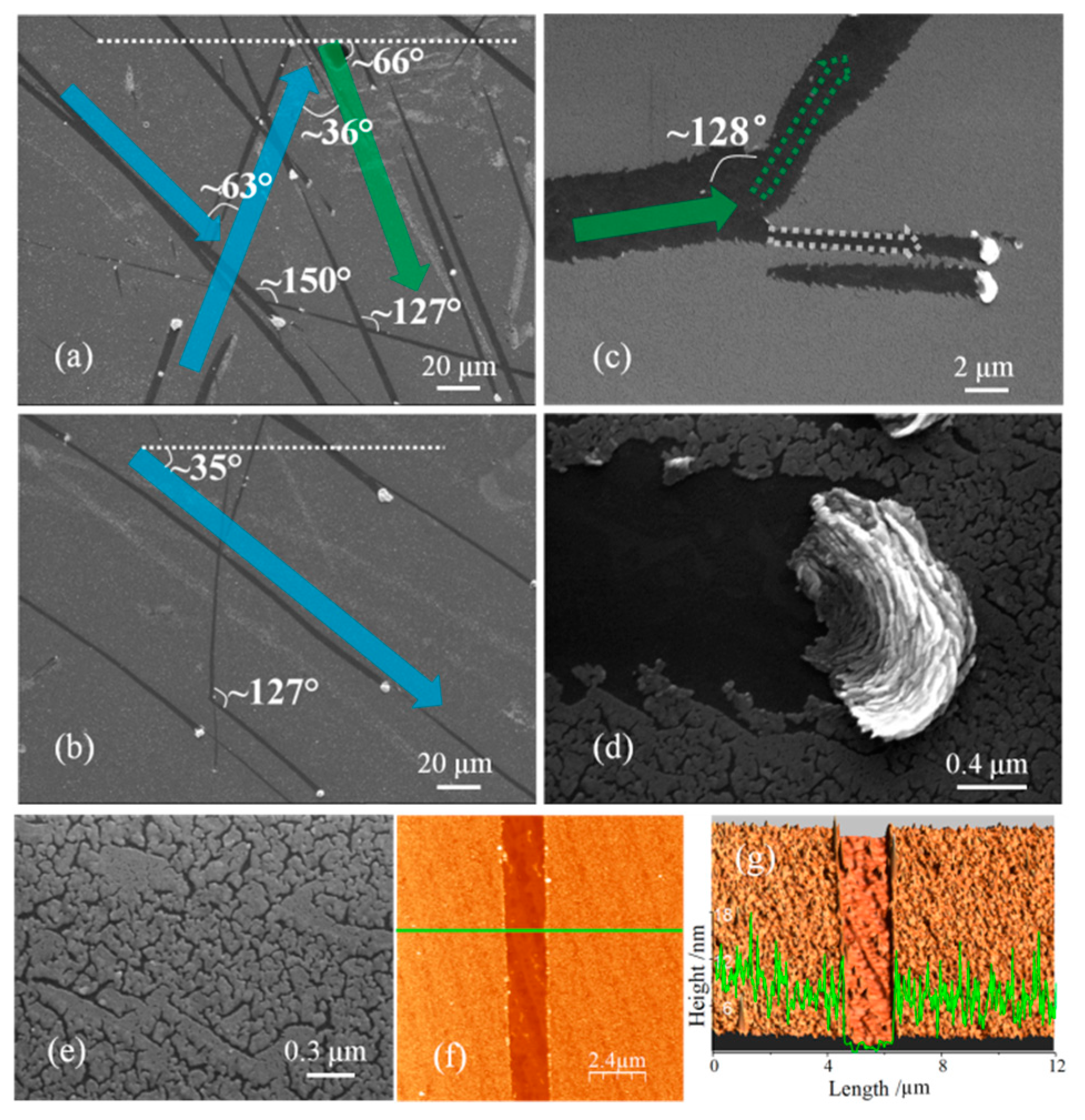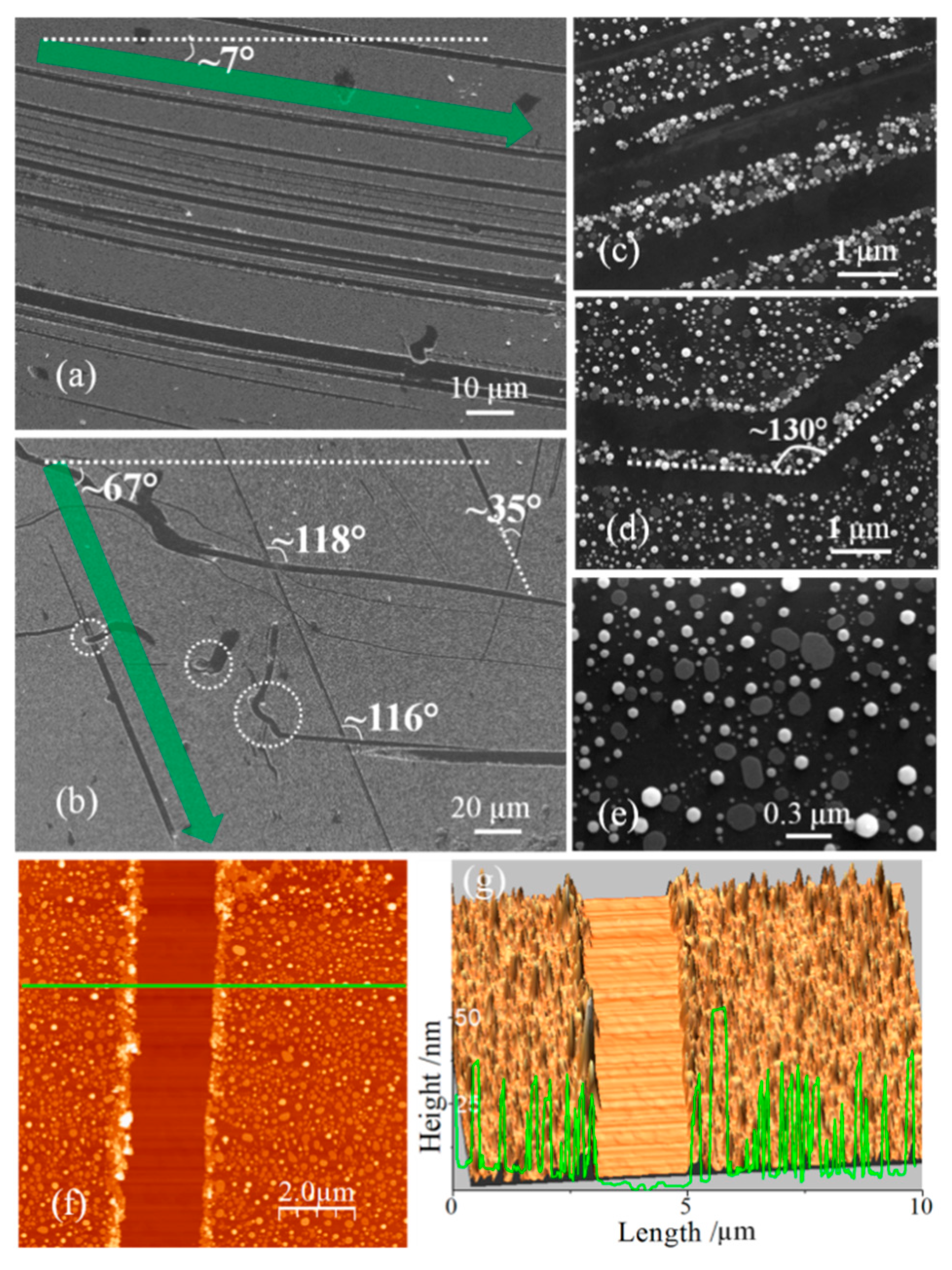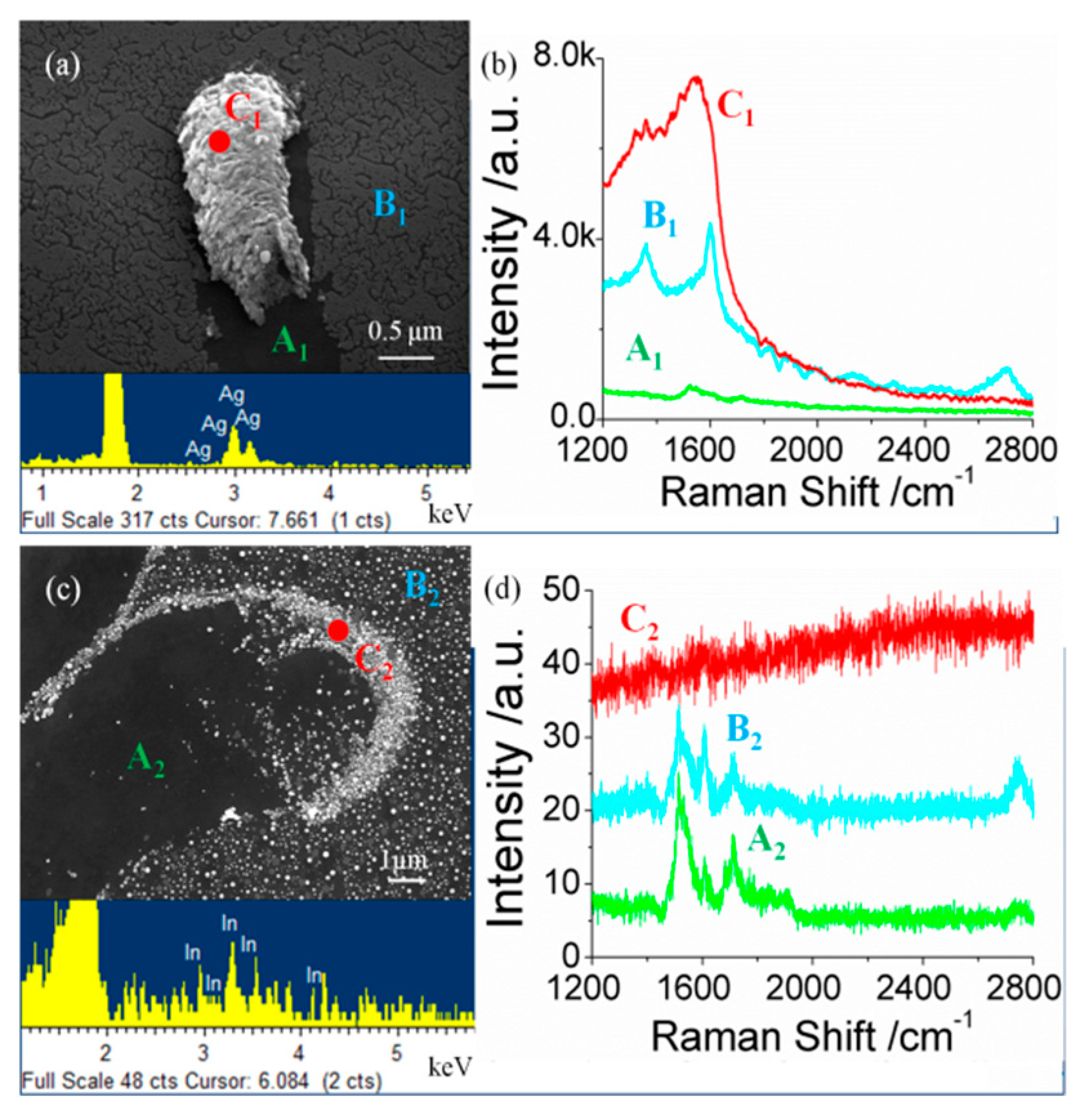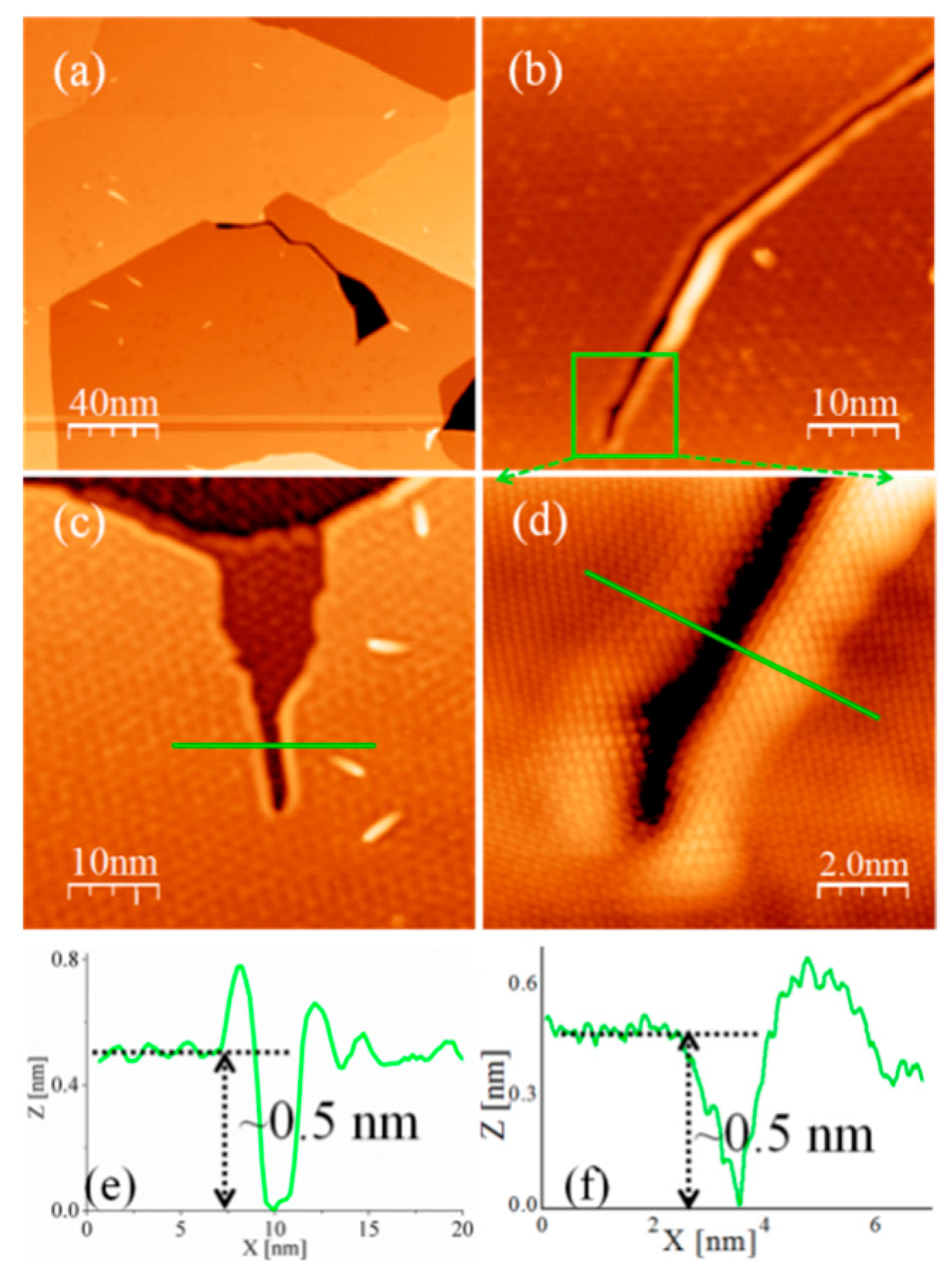Formation of Micro- and Nano-Trenches on Epitaxial Graphene
Abstract
1. Introduction
2. Experiments
3. Results and Discussions
4. Conclusions
Author Contributions
Funding
Conflicts of Interest
References
- Novoselov, K.S.; Fal’ko, V.I.; Colombo, L.; Gellert, P.R.; Schwab, M.G.; Kim, K. A roadmap for graphene. Nature 2012, 490, 192–200. [Google Scholar] [CrossRef]
- Zhang, T.; Wu, S.; Yang, R.; Zhang, G. Graphene: Nanostructure engineering and applications. Front. Phys. 2017, 12, 127206. [Google Scholar] [CrossRef]
- Yu, R.; Manjavacas, A.; Garcia de Abajo, F.J. Ultrafast radiative heat transfer. Nat. Commun. 2017, 8, 2. [Google Scholar] [CrossRef] [PubMed]
- Novoselov, K.S.; Geim, A.K.; Morozov, S.V.; Jiang, D.; Zhang, Y.; Dubonos, S.V.; Grigorieva, I.V.; Firsov, A.A. Electric field effect in atomically thin carbon films. Science 2004, 306, 666–669. [Google Scholar] [CrossRef] [PubMed]
- Cai, J.; Ruffieux, P.; Jaafar, R.; Bieri, M.; Braun, T.; Blankenburg, S.; Muoth, M.; Seitsonen, A.P.; Saleh, M.; Feng, X.; et al. Atomically precise bottom-up fabrication of graphene nanoribbons. Nature 2010, 466, 470–473. [Google Scholar] [CrossRef] [PubMed]
- Yang, W.; Chen, G.; Shi, Z.; Liu, C.; Zhang, L.; Xie, G.; Cheng, M.; Wang, D.; Yang, R.; Shi, D.; et al. Epitaxial growth of single-domain graphene on hexagonal boron nitride. Nat. Mater. 2013, 12, 792–797. [Google Scholar] [CrossRef]
- Zheng, Y.; Wang, H.; Hou, S.; Xia, D. Lithographically defined graphene patterns. Adv. Mater. Technol. 2017, 2, 1600237. [Google Scholar] [CrossRef]
- Geng, D.; Wang, H.; Wan, Y.; Xu, Z.; Luo, B.; Xu, J.; Yu, G. Direct top-down fabrication of large-area graphene arrays by an in situ etching method. Adv. Mater. 2015, 27, 4195–4199. [Google Scholar] [CrossRef]
- Wang, X.; Dai, H. Etching and narrowing of graphene from the edges. Nat. Chem. 2010, 2, 661–665. [Google Scholar] [CrossRef] [PubMed]
- Chen, K.; Chu, T.; Wu, C.; Lee, S.; Lin, S. Atomic layer etchings of transition metal dichalcogenides with post healing procedures: Equivalent selective etching of 2D crystal hetero-structures. 2D Mater. 2017, 4, 034001. [Google Scholar] [CrossRef]
- Lukas, M.; Meded, V.; Vijayaraghavan, A.; Song, L.; Ajayan, P.M.; Fink, K.; Wenzel, W.; Krupke, R. Catalytic subsurface etching of nanoscale channels in graphite. Nat. Commun. 2013, 4, 1379. [Google Scholar] [CrossRef] [PubMed]
- Oberhuber, F.; Blien, S.; Schupp, F.; Weiss, D.; Eroms, J. Anisotropic etching of graphene in inert and oxygen atmospheres. Phys. Status Solidi A 2017, 214, 1600459. [Google Scholar] [CrossRef]
- Schröder, U.A.; Grånäs, E.; Gerber, T.; Arman, M.A.; Martínez-Galera, A.J.; Schulte, K.; Andersen, J.N.; Knudsen, J.; Michely, T. Etching of graphene on Ir(111) with molecular oxygen. Carbon 2016, 96, 320–331. [Google Scholar] [CrossRef]
- Leong, W.S.; Gong, H.; Thong, J.T.L. Low-contact-resistance graphene devices with nickel-etched-graphene contacts. ACS Nano 2014, 8, 994–1001. [Google Scholar] [CrossRef]
- Ma, L.; Wang, J.; Yip, J.; Ding, F. Mechanism of transition-metal nanoparticle catalytic graphene cutting. J. Phys. Chem. Lett. 2014, 5, 1192–1197. [Google Scholar] [CrossRef]
- Qiu, Z.; Song, L.; Zhao, J.; Li, Z.; Yang, J. The nanoparticle size effect in graphene cutting A “Pac-Man” mechanism. Angew. Chem.-Int. Ed. 2016, 55, 9918–9921. [Google Scholar] [CrossRef] [PubMed]
- Jin, J.E.; Lee, J.-H.; Choi, J.H.; Jang, H.-K.; Na, J.; Whang, D.; Kim, D.-H.; Kim, G.T. Catalytic etching of monolayer graphene at low temperature via carbon oxidation. Phys. Chem. Chem. Phys. 2016, 18, 101–109. [Google Scholar] [CrossRef]
- Cheng, G.; Calizo, I.; Hacker, C.A.; Richter, C.A.; Hight Walker, A.R. Fe-catalyzed etching of exfoliated graphite through carbon hydrogenation. Carbon 2016, 96, 311–315. [Google Scholar] [CrossRef]
- Manadé, M.; Viñes, F.; Illas, F. Transition metal adatoms on graphene: A systematic density functional study. Carbon 2015, 95, 525–534. [Google Scholar] [CrossRef]
- Liu, X.; Wang, C.-Z.; Hupalo, M.; Lin, H.-Q.; Ho, K.-M.; Tringides, M. Metals on graphene: Interactions, growth morphology, and thermal stability. Crystals 2013, 3, 79–111. [Google Scholar] [CrossRef]
- Legesse, M.; Mellouhi, F.E.; Bentria, E.T.; Madjet, M.E.; Fisher, T.S.; Kais, S.; Alharbi, F.H. Reduced work function of graphene by metal adatoms. Appl. Surf. Sci. 2017, 394, 98–107. [Google Scholar] [CrossRef]
- Liu, X.T.; Hu, T.W.; Miao, Y.P.; Ma, D.Y.; Chu, P.K.; Ma, F.; Xu, K.W. Selective growth of Pb islands on graphene/SiC buffer layers. J. Appl. Phys. 2015, 117, 065304. [Google Scholar] [CrossRef]
- Hu, T.; Hui, X.; Zhang, X.; Liu, X.; Ma, D.; Wei, R.; Xu, K.; Ma, F. Nanostructured Bi Grown on Epitaxial Graphene/SiC. J. Phys. Chem. Lett. 2018, 9, 5679–5684. [Google Scholar] [CrossRef] [PubMed]
- Oh, J.; Kim, K.; Yeom, G. Graphene doping methods and device applications. J. Nanosci. Nanotechnol. 2014, 14, 1120–1133. [Google Scholar] [CrossRef] [PubMed]
- Kim, S.; Shin, S.; Kim, T.; Du, H.; Song, M.; Kim, K.; Lee, S.; Seo, S. A reliable and controllable graphene doping method compatible with current CMOS technology and the demonstration of its device applications. Nanotechnology 2017, 28, 175710. [Google Scholar] [CrossRef] [PubMed]
- Dianat, A.; Liao, Z.; Gall, M.; Zhang, T.; Gutierrez, R.; Zschech, E.; Cuniberti, G. Doping of graphene induced by boron/silicon substrate. Nanotechnology 2017, 28, 215701. [Google Scholar] [CrossRef]
- Hu, T.; Fang, Q.; Zhang, X.; Liu, X.; Ma, D.; Wei, R.; Xu, K.; Ma, F. Enhanced n-doping of epitaxial graphene on SiC by bismuth. Appl. Phys. Lett. 2018, 113, 011602. [Google Scholar] [CrossRef]
- Hardcastle, T.P.; Seabourne, C.R.; Zan, R.; Brydson, R.M.D.; Bangert, U.; Ramasse, Q.M.; Novoselov, K.S.; Scott, A.J. Mobile metal adatoms on single layer, bilayer, and trilayer graphene: An ab initio DFT study with van der Waals corrections correlated with electron microscopy data. Phys. Rev. B 2013, 87, 195430. [Google Scholar] [CrossRef]
- Asadi, K.; Timmering, E.C.; Geuns, T.C.; Pesquera, A.; Centeno, A.; Zurutuza, A.; Klootwijk, J.H.; Blom, P.W.; de Leeuw, D.M. Up-scaling graphene electronics by reproducible metal-graphene contacts. ACS Appl. Mater. Interfaces 2015, 7, 9429–9435. [Google Scholar] [CrossRef]
- Anithaa, V.S.; Shankar, R.; Vijayakumar, S. Adsorption of Mn atom on pristine and defected graphene: A density functional theory study. J. Mol. Model. 2017, 23, 132. [Google Scholar] [CrossRef]
- García-Rodríguez, D.E.; Mendoza-Huizar, L.H.; Díaz, C. A DFT study of Cu nanoparticles adsorbed on defective graphene. Appl. Surf. Sci. 2017, 412, 146–151. [Google Scholar] [CrossRef]
- Pallecchi, E.; Lafont, F.; Cavaliere, V.; Schopfer, F.; Mailly, D.; Poirier, W.; Ouerghi, A. High electron mobility in epitaxial graphene on 4H-SiC(0001) via post-growth annealing under hydrogen. Sci. Rep. 2014, 4, 4558. [Google Scholar] [CrossRef]
- Baringhaus, J.; Ruan, M.; Edler, F.; Tejeda, A.; Sicot, M.; Taleb-Ibrahimi, A.; Li, A.P.; Jiang, Z.; Conrad, E.H.; Berger, C.; et al. Exceptional ballistic transport in epitaxial graphene nanoribbons. Nature 2014, 506, 349–354. [Google Scholar] [CrossRef] [PubMed]
- Hu, T.W.; Liu, X.T.; Ma, F.; Ma, D.Y.; Xu, K.W.; Chu, P.K. High-quality, single-layered epitaxial graphene fabricated on 6H-SiC (0001) by flash annealing in Pb atmosphere and mechanism. Nanotechnology 2015, 26, 105708. [Google Scholar] [CrossRef] [PubMed]
- Hass, J.; de Heer, W.A.; Conrad, E.H. The growth and morphology of epitaxial multilayer graphene. J. Phys.-Condes. Matter 2008, 20, 323202. [Google Scholar] [CrossRef]
- Severin, N.; Kirstein, S.; Sokolov, I.M.; Rabe, J.P. Rapid trench channeling of graphenes with catalytic silver nanoparticles. Nano Lett. 2009, 9, 457–461. [Google Scholar] [CrossRef] [PubMed]
- Ci, L.; Xu, Z.; Wang, L.; Gao, W.; Ding, F.; Kelly, K.F.; Yakobson, B.I.; Ajayan, P.M. Controlled nanocutting of graphene. Nano Res. 2008, 1, 116–122. [Google Scholar] [CrossRef]
- Courty, A.; Henry, A.I.; Goubet, N.; Pileni, M.P. Large triangular single crystals formed by mild annealing of self-organized silver nanocrystals. Nat. Mater. 2007, 6, 900–907. [Google Scholar] [CrossRef]
- Zhao, H.; Guo, Y.; Zhu, S.; Song, Y.; Jin, J.; Ji, W.; Song, W.; Zhao, B.; Yang, B.; Ozaki, Y. Facile synthesis of silver nanoparticles/carbon dots for a charge transfer study and peroxidase-like catalytic monitoring by surface-enhanced Raman scattering. Appl. Surf. Sci. 2017, 410, 42–50. [Google Scholar] [CrossRef]
- Sun, Q.; Zhang, Y.; Sun, L.; Yang, Y.; Min, C.; Zhu, S.; Yuan, X. Microscopic surface plasmon enhanced raman spectral imaging. Opt. Commun. 2017, 392, 64–67. [Google Scholar] [CrossRef]
- Xu, W.; Mao, N.; Zhang, J. Graphene: A platform for surface-enhanced Raman spectroscopy. Small 2013, 9, 1206–1224. [Google Scholar] [CrossRef] [PubMed]
- Hatakeyama, T.; Kometani, R.; Warisawa, S.i.; Ishihara, S. Selective graphene growth from DLC thin film patterned by focused-ion-beam chemical vapor deposition. J. Vac. Sci. Technol. B 2011, 29, 06FG04. [Google Scholar] [CrossRef]
- Chu, P.K.; Li, L. Characterization of amorphous and nanocrystalline carbon films. Mater. Chem. Phys. 2006, 96, 253–277. [Google Scholar] [CrossRef]
- Tesch, J.; Leicht, P.; Blumenschein, F.; Gragnaniello, L.; Bergvall, A.; Löfwander, T.; Fonin, M. Impurity scattering and size quantization effects in a single graphene nanoflake. Phys. Rev. B 2017, 95, 075429. [Google Scholar] [CrossRef]





© 2018 by the authors. Licensee MDPI, Basel, Switzerland. This article is an open access article distributed under the terms and conditions of the Creative Commons Attribution (CC BY) license (http://creativecommons.org/licenses/by/4.0/).
Share and Cite
Hu, T.; Liu, X.; Ma, D.; Wei, R.; Xu, K.; Ma, F. Formation of Micro- and Nano-Trenches on Epitaxial Graphene. Appl. Sci. 2018, 8, 2518. https://doi.org/10.3390/app8122518
Hu T, Liu X, Ma D, Wei R, Xu K, Ma F. Formation of Micro- and Nano-Trenches on Epitaxial Graphene. Applied Sciences. 2018; 8(12):2518. https://doi.org/10.3390/app8122518
Chicago/Turabian StyleHu, Tingwei, Xiangtai Liu, Dayan Ma, Ran Wei, Kewei Xu, and Fei Ma. 2018. "Formation of Micro- and Nano-Trenches on Epitaxial Graphene" Applied Sciences 8, no. 12: 2518. https://doi.org/10.3390/app8122518
APA StyleHu, T., Liu, X., Ma, D., Wei, R., Xu, K., & Ma, F. (2018). Formation of Micro- and Nano-Trenches on Epitaxial Graphene. Applied Sciences, 8(12), 2518. https://doi.org/10.3390/app8122518





